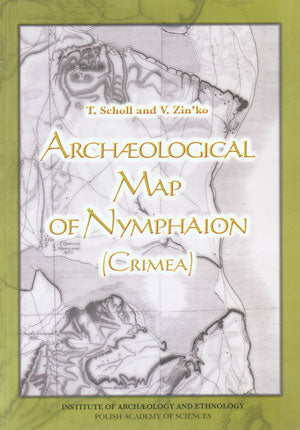Archaeological Map of Nymphaion (Crimea)
8,00 $
ISBN: 83-85463-82-8
Description: 126 pages (30x21), drawings, photographs, plans, maps
Condition: new
Weight: 505g.
T. Scholl, V. Zin'ko, Archaeological Map of Nymphaion (Crimea), Institute of Archaeology, Polish Academy of Sciences, Warsaw 1999
EDITOR'S PREFACE
INTRODUCTION
I. CATALOGUE OF THE SITES
II. SITE DESCRIPTION
II.1. Settlements (nos. 1-42)
II.2. Necropolises (nos. 1-16)
II.3. Plots (nos. 1-5)
II.4. Wall, pathways, quarries, pipeline (nos. 1-10)
II.5. Structures discovered under water (nos. 1-5)
III. SPECIAL FINDS
III. 1. Lithic artefacts by M. Bednarz
III.2. Ceramic stamps by N. Fedoseev
III.3. Rock analysis by M. Mazzuchelli
III.4. Sculptures by E. Zin'ko
III.5. Clay tobacco pipes by K. Meyza
CONCLUSIONS
ABBREVIATIONS
ARCHIVES
BIBLIOGRAPHY
SUMMARY IN RUSSIAN
TABLES MAPS
The Archaeological Map of Nymphaion is just one of the results of a five-year-long period of (1993-1997) Polish-Russian-Ukrainian cooperation carried out within the terms of reference of the project: "Nymphaion: the History and Structure of a Greek polis."
International studies of this Greek colony, probably established by Miletus in the 6th century B.C.,1 were begun in 1993 at the suggestion of the then director of the Kcrc Museum, professor Eleonora Jakovenko.
Within the boundaries of international agreements subsequently reached, the participants in the project were: the Archaeological Museum in Kerc and the Hermitage Museum in Saint Petersburg (from 1993), the State Committee for the Protection of Historical Monuments of Crimea in Simferopol' (from 1994), the Centre National de la Recherche Scientifiquc in Nantes (from 1994), and, from the very beginning, as one of the parties initiating the cooperation, the Institute of Archaeology and Ethnology at the Polish Academy of Sciences, Warsaw. Without a special agreement the work was shared out between other institutions, especially the Institute of Archaeology at Warsaw University (from 1993) and, as the necessity arose, by employees of the Institute of History at the University of Wroclaw, the Insitutc of Geological Sciences at Polish Academy of Sciences, and the Arbeitsgruppe Archiio-mctrie der Freien Universitat, Berlin.
The aim of the Project was to study the history and structure of a Greek colony, Nymphaion2 in its totality. This embraced the investigation -of both the town and its rural hinterland (chora), as well as various aspects of the life of its inhabitants in Antiquity, i.a., economy, culture, and social and ethnic relations. For this end various categories of source material were used: archaeological, iconographic, literary, epigraphic, and palaeozoological ones, as well as various methods: field survey, excavation, geophysical and underwater survey, cartography, and analysis of satellite pictures. It was intended to carry out parallelly various forms of research work, i.a., field work, studies of source materials, studies of selected historical problems, preparation of publications, and working conferences (of the round table type).
It seems appropriate to explain why Nymphaion, a relatively small, but important colony located to the south of Kerc (ancient Pantikapaion), on the western shore of the Kerc Strait (Bosphorus Cimmericus), was selected as a subject of the investigation. Nymphaion became the focus of our interest because it provided optimum conditions for the accomplishment of the aims of the Project. Firstly, it was a relatively small colony (in comparison to, e.g., Pantikapaion or Olbia), and thus it was easier to study the problems involved in their totality. Secondly, the neighbourhood of the Ancient town is not covered with buildings and this made it possible to study the chora. Finally, and perhaps most importantly for our part, the excavations conducted in the area of the town since 1939 by the Hermitage Museum have yielded impressive results, which offered further interesting research prospects. So far a large section of fortifications, numerous sanctuaries, residential buildings, and other structures have been uncovered.
During the 5 year long research, the ambitious (as we had realised from the very beginning) plans were carried out to a different extent: some topics have been thoroughly examined, other ones shall soon be presented in publications, some have been abandoned. The current state of these various avenues of research is presented in recent publications and literature.......

